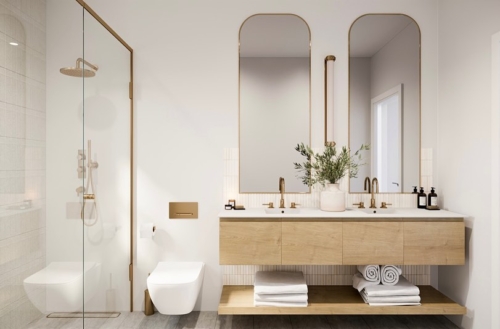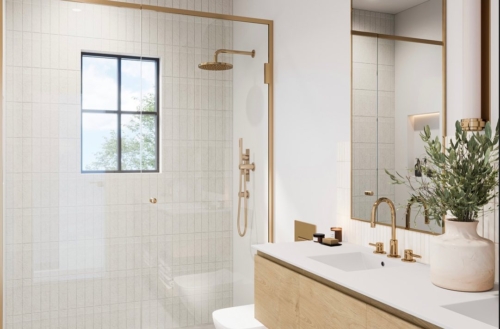Sustainable bathroom design goes beyond aesthetics and functionality; it focuses on minimizing environmental impact and promoting eco-friendly practices. From water conservation to the use of renewable materials, incorporating sustainable design principles in your bathroom can contribute to a greener future.
In this article, we will explore key elements of sustainable design in bathrooms, providing you with practical ideas to create an eco-friendly space that combines style and sustainability.
Sustainable Bathroom Design
What is a sustainable bathroom design? It is the practice of creating a space that minimizes its environmental impact, promotes resource conservation, and prioritizes the use of eco-friendly materials and practices. It involves making conscious choices throughout the design process to reduce energy consumption, water waste, and the use of harmful chemicals.
1. Water Efficiency
Water conservation is a vital aspect of sustainable bathroom design. Implementing water-efficient fixtures is crucial in reducing water consumption.
Install low-flow toilets, aerated faucets, and showerheads that maintain performance while minimizing water usage. Dual-flush toilets offer an added advantage by providing options for full or partial flushes, conserving water based on the need. Additionally, consider capturing and reusing graywater from sinks and showers for toilet flushing or plant watering.
2. Energy-Efficient Lighting
Energy-efficient lighting is a fundamental element of sustainable bathroom design.
Replace traditional incandescent bulbs with energy-saving LED or CFL lights. These bulbs use less electricity, last longer, and produce less heat. Incorporate natural lighting by maximizing window size or adding skylights to reduce reliance on artificial lighting during the day. Utilize motion-sensing switches or timers to ensure lights are only active when necessary, reducing unnecessary energy consumption.
3. Renewable and Recycled Materials
Choosing renewable and recycled materials is essential for sustainable bathroom design.
Opt for materials like bamboo, which is a fast-growing and renewable resource, for flooring, vanities, and accessories. Recycled glass tiles or countertops made from reclaimed materials offer a unique and eco-friendly touch. Additionally, consider salvaged or reclaimed wood for cabinets, shelves, or accent pieces. These materials help reduce deforestation and minimize waste while adding a natural and stylish appeal to your bathroom.
4. Non-Toxic and Low VOC Materials
Using non-toxic and low VOC (volatile organic compound) materials promotes better indoor air quality and a healthier bathroom environment.
Look for eco-friendly paints, adhesives, and finishes that are low in VOC content. Choose water-based, natural, or plant-based products to minimize off-gassing of harmful chemicals. Prioritize natural and sustainable options for flooring, such as cork or linoleum, which are made from renewable resources and are free of toxic additives.
5. Efficient Ventilation
Proper ventilation is crucial in preventing moisture-related issues and maintaining a healthy bathroom environment.
Install energy-efficient ventilation systems that extract excess moisture and odors while minimizing energy consumption. Consider utilizing passive ventilation techniques such as strategically placed windows or vents to encourage natural airflow. Proper ventilation not only helps in reducing mold and mildew growth but also improves air quality and overall comfort in the bathroom.
6. Waterproofing and Sustainable Sealants
In sustainable bathroom design, choose waterproofing materials and sealants that are eco-friendly.
Opt for products that are free from harmful chemicals, solvents, or heavy metals. Seek out eco-friendly options such as water-based sealants or those certified as environmentally friendly. These choices minimize environmental impact during the installation process and contribute to a healthier and sustainable bathroom.
7. Green Cleaning and Maintenance
Sustainable bathroom design extends to cleaning and maintenance practices.
Choose environmentally friendly and non-toxic cleaning products that are biodegradable and safe for both human health and the ecosystem. Consider making your own cleaning solutions using natural ingredients like vinegar, baking soda, and lemon juice. Implement regular maintenance routines to ensure proper functioning of fixtures, plumbing, and ventilation systems, reducing the need for excessive repairs and replacements.
Overall, sustainable design in bathrooms is about more than just creating visually appealing spaces; it involves conscious choices to minimize environmental impact and promote eco-friendly practices. By incorporating elements such as water efficiency, energy-efficient lighting, renewable materials, and non-toxic products, you can create a bathroom that is both stylish and sustainable.
Embrace these ideas and design a bathroom that reflects your commitment to a greener future, making a positive impact on the environment while enjoying a functional and aesthetically pleasing space.
Check out The Top Sustainable Bathroom Tile Options for a Greener Home for more sustainable design ideas.
About Us:
Founded in 2017, Satin and Slate is one of the elite interior design studios in Southern California. Located in Long Beach, this dedicated team of designers oversees from kitchen and bathroom renovations to commercial projects. Equipped with their own showroom/studio they can satisfy the needs of any client. Featuring clean lines, bright colors and fresh ideas Satin and Slate’s mission is to bring your vision to life and help transform your space into something extraordinary.









